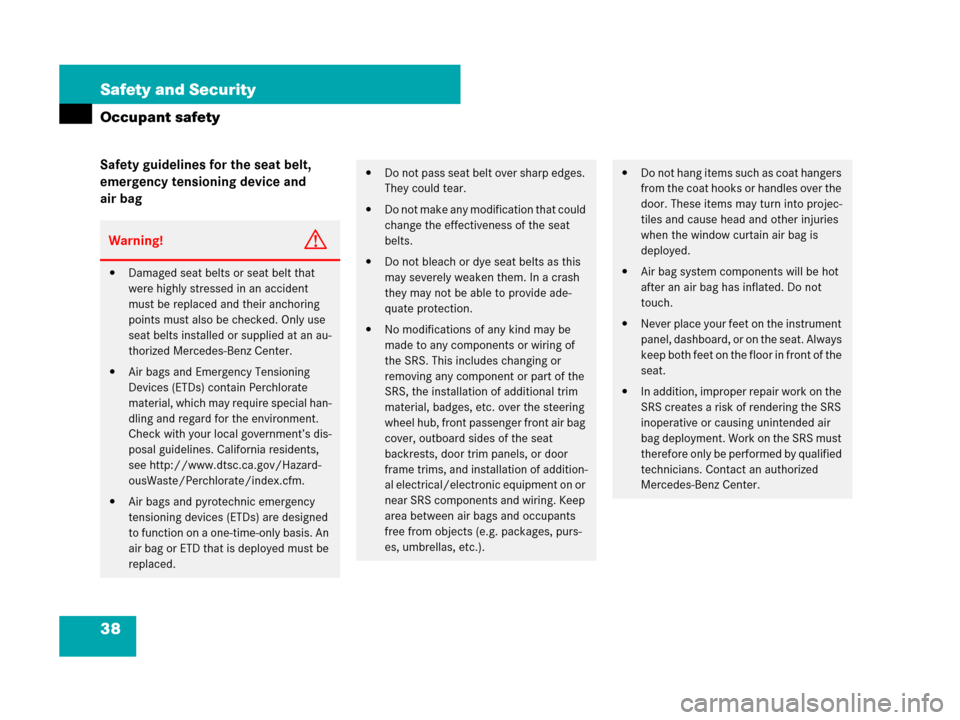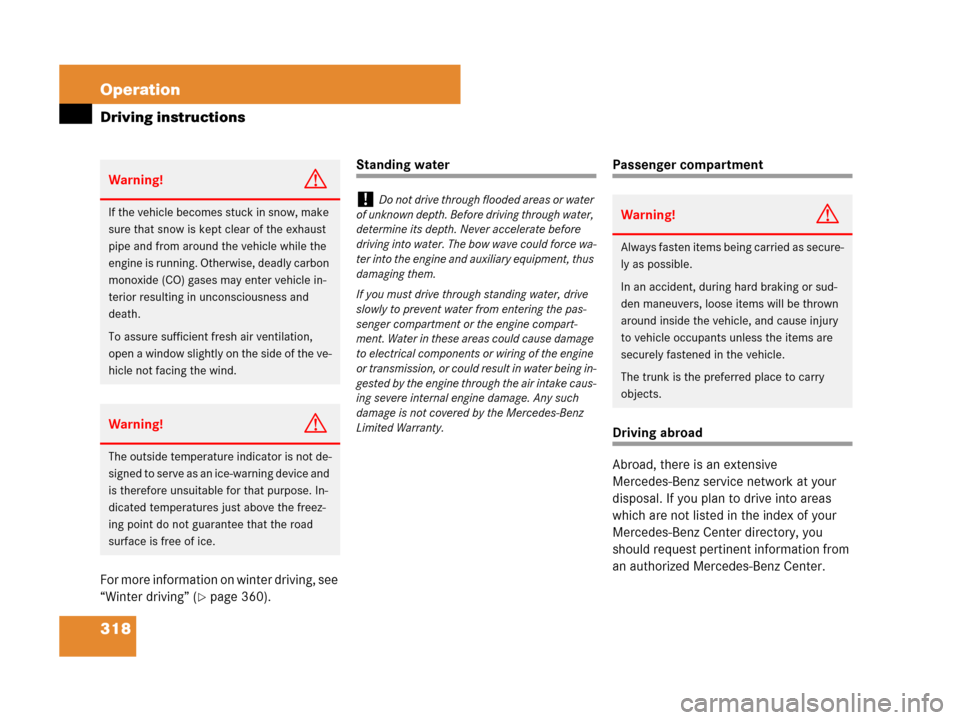Page 36 of 509

35 Safety and Security
Occupant safety
Warning!G
Modifications to or work improperly con-
ducted on restraint systems (such as seat
belts and anchors, Emergency Tensioning
Devices (ETDs), seat belt force limiters or air
bags) or their wiring, as well as tampering
with interconnected electronic systems, can
lead to the restraint systems no longer func-
tioning as intended.
Air bags or Emergency Tensioning Devices
(ETDs), for example, could deploy inadvert-
ently or fail to deploy in accidents although
the deceleration threshold for air bag de-
ployment is exceeded. Therefore, never
modify the restraint systems. Do not tamper
with electronic components or their soft-
ware.
Warning!G
In the event that the =indicator lamp
comes on during driving or does not come
on at all, the SRS self-check has detected a
malfunction. For your safety, we strongly
recommend that you contact an authorized
Mercedes-Benz Center immediately to have
the system checked; otherwise the SRS may
not deploy when needed in an accident,
which could result in serious or fatal injury,
or it might deploy unexpectedly and unnec-
essarily which could also result in injury.
In addition, improper work on the SRS
creates a risk of rendering the SRS inopera-
tive or causing unintended air bag deploy-
ment. Work on the SRS must therefore only
be performed by qualified technicians. Con-
tact an authorized Mercedes-Benz Center.
If it is necessary to modify an air bag system
to accommodate a person with disabilities,
contact your local authorized
Mercedes-Benz Center or call our Customer
Assistance Center at 1-800-FOR-MERCedes
(1-800-367-6372) for details.
Page 39 of 509

38 Safety and Security
Occupant safety
Safety guidelines for the seat belt,
emergency tensioning device and
air bag
Warning!G
�Damaged seat belts or seat belt that
were highly stressed in an accident
must be replaced and their anchoring
points must also be checked. Only use
seat belts installed or supplied at an au-
thorized Mercedes-Benz Center.
�Air bags and Emergency Tensioning
Devices (ETDs) contain Perchlorate
material, which may require special han-
dling and regard for the environment.
Check with your local government’s dis-
posal guidelines. California residents,
see http://www.dtsc.ca.gov/Hazard-
ousWaste/Perchlorate/index.cfm.
�Air bags and pyrotechnic emergency
tensioning devices (ETDs) are designed
to function on a one-time-only basis. An
air bag or ETD that is deployed must be
replaced.
�Do not pass seat belt over sharp edges.
They could tear.
�Do not make any modification that could
change the effectiveness of the seat
belts.
�Do not bleach or dye seat belts as this
may severely weaken them. In a crash
they may not be able to provide ade-
quate protection.
�No modifications of any kind may be
made to any components or wiring of
the SRS. This includes changing or
removing any component or part of the
SRS, the installation of additional trim
material, badges, etc. over the steering
wheel hub, front passenger front air bag
cover, outboard sides of the seat
backrests, door trim panels, or door
frame trims, and installation of addition-
al electrical/electronic equipment on or
near SRS components and wiring. Keep
area between air bags and occupants
free from objects (e.g. packages, purs-
es, umbrellas, etc.).
�Do not hang items such as coat hangers
from the coat hooks or handles over the
door. These items may turn into projec-
tiles and cause head and other injuries
when the window curtain air bag is
deployed.
�Air bag system components will be hot
after an air bag has inflated. Do not
touch.
�Never place your feet on the instrument
panel, dashboard, or on the seat. Always
keep both feet on the floor in front of the
seat.
�In addition, improper repair work on the
SRS creates a risk of rendering the SRS
inoperative or causing unintended air
bag deployment. Work on the SRS must
therefore only be performed by qualified
technicians. Contact an authorized
Mercedes-Benz Center.
Page 319 of 509

318 Operation
Driving instructions
For more information on winter driving, see
“Winter driving” (
�page 360).
Standing waterPassenger compartment
Driving abroad
Abroad, there is an extensive
Mercedes-Benz service network at your
disposal. If you plan to drive into areas
which are not listed in the index of your
Mercedes-Benz Center directory, you
should request pertinent information from
an authorized Mercedes-Benz Center.
Warning!G
If the vehicle becomes stuck in snow, make
sure that snow is kept clear of the exhaust
pipe and from around the vehicle while the
engine is running. Otherwise, deadly carbon
monoxide (CO) gases may enter vehicle in-
terior resulting in unconsciousness and
death.
To assure sufficient fresh air ventilation,
open a window slightly on the side of the ve-
hicle not facing the wind.
Warning!G
The outside temperature indicator is not de-
signed to serve as an ice-warning device and
is therefore unsuitable for that purpose. In-
dicated temperatures just above the freez-
ing point do not guarantee that the road
surface is free of ice.
!Do not drive through flooded areas or water
of unknown depth. Before driving through water,
determine its depth. Never accelerate before
driving into water. The bow wave could force wa-
ter into the engine and auxiliary equipment, thus
damaging them.
If you must drive through standing water, drive
slowly to prevent water from entering the pas-
senger compartment or the engine compart-
ment. Water in these areas could cause damage
to electrical components or wiring of the engine
or transmission, or could result in water being in-
gested by the engine through the air intake caus-
ing severe internal engine damage. Any such
damage is not covered by the Mercedes-Benz
Limited Warranty.
Warning!G
Always fasten items being carried as secure-
ly as possible.
In an accident, during hard braking or sud-
den maneuvers, loose items will be thrown
around inside the vehicle, and cause injury
to vehicle occupants unless the items are
securely fastened in the vehicle.
The trunk is the preferred place to carry
objects.